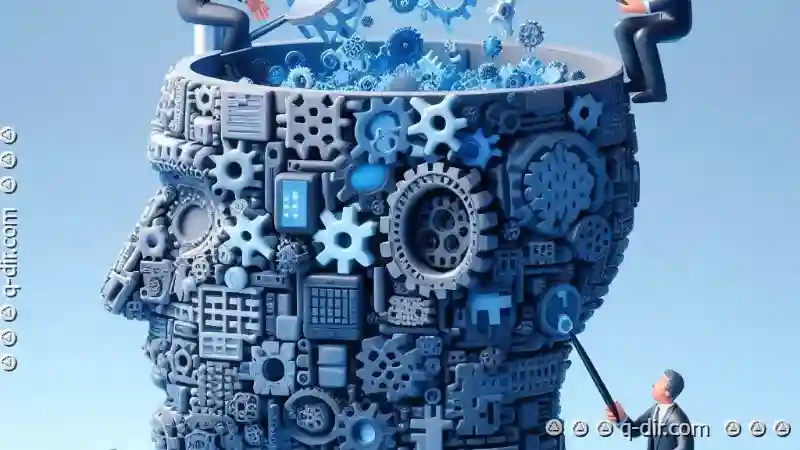The concept of "favorites" has long been a cornerstone for simplifying access within software applications and devices. However, as we continue to ...
 accumulate more favorites, this paradigm begins to show its limitations-a phenomenon I like to call the "Favorites Overload" syndrome. This blog post will delve into why breaking free from this paradigm is imperative, and how embracing minimalism in navigation and display can revolutionize your digital experience. In today's digital age, where information overload is a reality, it's crucial to adopt strategies that help us manage and navigate through the deluge of data efficiently.
accumulate more favorites, this paradigm begins to show its limitations-a phenomenon I like to call the "Favorites Overload" syndrome. This blog post will delve into why breaking free from this paradigm is imperative, and how embracing minimalism in navigation and display can revolutionize your digital experience. In today's digital age, where information overload is a reality, it's crucial to adopt strategies that help us manage and navigate through the deluge of data efficiently.1. Understanding Favorites Overload
2. Why Breaking Free is Necessary
3. Embracing Minimalism in Navigation and Display
4. Conclusion
1.) Understanding Favorites Overload
The Burden of Choice
The initial appeal of favoriting items-be it websites, contacts, or content-is its simplicity: a single tap, click, or swipe transforms an item from potentially cluttered list into a conveniently bookmarked icon. However, as the number of favorites grows, so does the cognitive load associated with managing them effectively. Each favorite represents a potential point of access, which in turn requires mental effort to recall and execute when needed.
Inefficiency in Use
The issue becomes apparent when we consider how often users actually revisit their lists of favorites. A study by Nielsen Norman Group revealed that users typically visit only about 20% of their frequently used apps or sites. This suggests a significant portion of our favored resources are underutilized, yet remain cluttering the interface and demanding mental space during use.
2.) Why Breaking Free is Necessary
Mental Space for Essential Tasks
Our brains were not designed to manage an infinite number of tasks simultaneously. By overloading our navigation interfaces with favorites, we crowd out the mental space required for more critical cognitive functions like creative thinking or immediate decision-making in dynamic situations.
Reduced Friction for Actionable Insights
The primary goal of any digital tool is to facilitate quick and efficient actions. With too many favorites, there's an increased risk of slowing down this process by forcing users into unnecessary steps. Minimalism in navigation aims to streamline these processes, ensuring that the most used features or information are just a click or tap away.
Enhancing User Experience (UX)
From a UX perspective, simplicity breeds usability. By reducing the number of clicks required to reach actions and focusing on intuitive organization methods like context-based recommendations rather than rigid categorization based on favoriting, we can significantly improve user satisfaction and engagement.
3.) Embracing Minimalism in Navigation and Display
Personalized Home Screens
Instead of cluttering home screens with a myriad of icons, consider implementing dynamic home pages that adapt to your usage patterns. For instance, you might have different sections dedicated to frequently used apps during work hours and more recreational or social media options post-work. This adaptive display not only reduces clutter but also ensures easier access tailored to the context in which you're using your device.
Smart Filters and Suggestions
Use algorithms that filter out what’s relevant based on past behaviors, preferences, and real-time needs. For example, a shopping app could suggest products or services similar to items you've previously shown interest in, without requiring manual favoriting every time. This approach not only reduces the burden of user input but also increases relevance and utility.
Regular Audits for Clarity
Just as physical spaces benefit from periodic decluttering, digital interfaces can too. Conducting regular audits where you assess whether your favorites are still serving their purpose or if they've become obsolete is a proactive way to maintain an optimal navigation setup. Consider apps like Netflix that regularly suggest new content based on your viewing history rather than expecting users to manually keep track of every title they might enjoy.
Technology Support for Efficient Navigation
Ensure the digital tools you use support efficient navigation practices. For instance, many modern smartphones allow for app folders or smart grouping based on usage frequency and type. These features help in managing favorites without overwhelming the interface with too much information.
4.) Conclusion
Embracing minimalism in navigation and display is not just about decluttering; it's about empowering users to focus their mental energy on what truly matters-the tasks at hand or the insights that can be derived from our digital interactions. By breaking free from the constraints of a favorites-overload paradigm, we can cultivate an environment where efficiency, usability, and personalized experiences flourish. As we continue to navigate through this era of information abundance, let's aim for clarity and control over how we access and utilize our digital resources.

The Autor: / 0 2025-04-18
Read also!
Page-

Is Tab's "Convenience" Its Most Dangerous Deception?
One prevalent method is the use of tabs, which allow multiple sections or pages to be accessed through a single window, often saving space on the ...read more

How Favorites Reflect Our Need for Instant Access
This phenomenon is mirrored in how we manage and utilize our digital devices, particularly through the use of favorites or bookmarks. In this blog ...read more
How to Customize Icon Size and Spacing
Welcome to this comprehensive guide on how to customize icon size and spacing in your applications. Whether you are developing for mobile, desktop, ...read more